AI-assisted call transcription
Diabolocom’s artificial intelligence transcribes voice and transforms customer interactions into usable text in any language. Increase agent productivity and save processing time with call transcription.
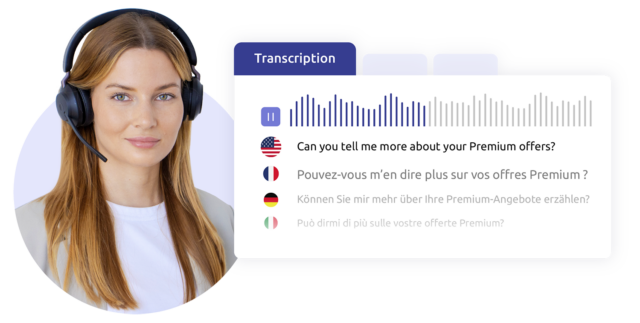












AI phone call transcription in any language
Diabolocom provides phone call transcription software that can be seamlessly integrated or accessed via API. This API-enabled solution instantly converts voice into text in any language, ensuring inclusive, multilingual customer service.
Unlock the full potential of your customer service with artificial intelligence. Our advanced AI technology lightens your agents’ workload by eliminating repetitive tasks before, during, and after customer interactions.
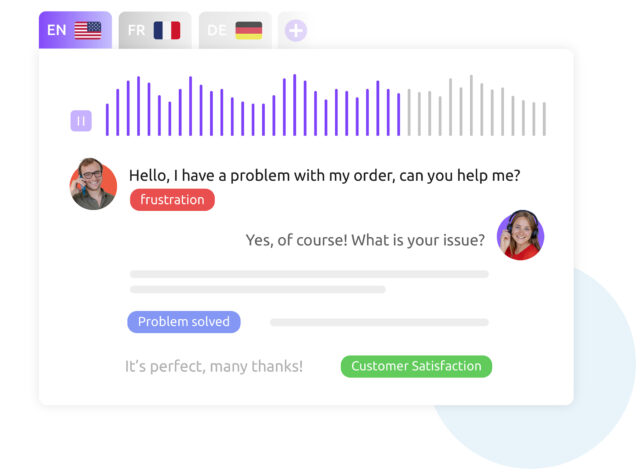
Leverage comprehensive data to better understand your customers
Transform every customer interaction into a goldmine of information with our advanced call transcription service. Make the most of your data, to refine your understanding of customer needs and preferences, increase efficiency with a significantly reduced context-taking time, and excel in resolving problems quickly.
Empower yourself to offer more relevant answers, accelerate processing times and propel customer satisfaction to unprecedented levels. Transform each call into a strategic asset for your customer service.
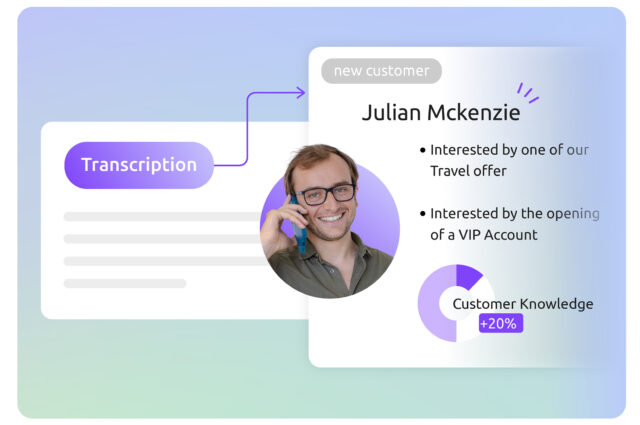
Streamlining workflows
Diabolocom’s transcription features significantly lighten the workload associated with documenting communications. Your sales and customer support teams can then optimize their processes and dedicate more time to their customers.
With Diabolocom, your sales and customer service teams benefit from centralized information, eliminating the necessity to re-listen to time-consuming phone calls or constantly ask colleagues for the data they need.
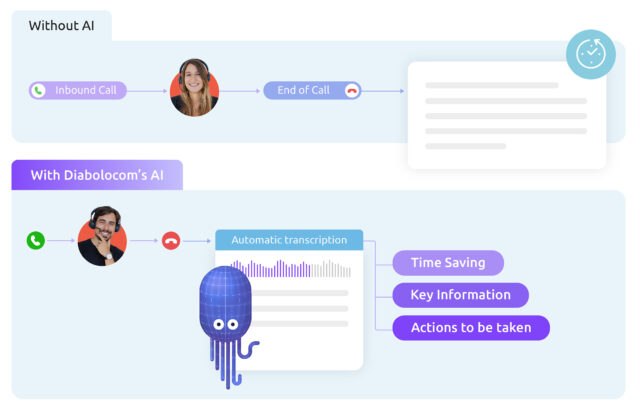
Better agent training for greater customer satisfaction
Boost agent training with AI-enabled call transcription. More than just training, it’s an immersion in proven exchanges that guide your reps towards excellence. Utilizing sample scripts from your top-performing calls, they learn directly from successful interactions, adopting the tone and techniques that win customers’ trust.
Expose newcomers to real-life scenarios, arm them against the unexpected and hone their responsiveness. Feedback becomes personalized lessons, targeting areas for improvement with concrete examples.
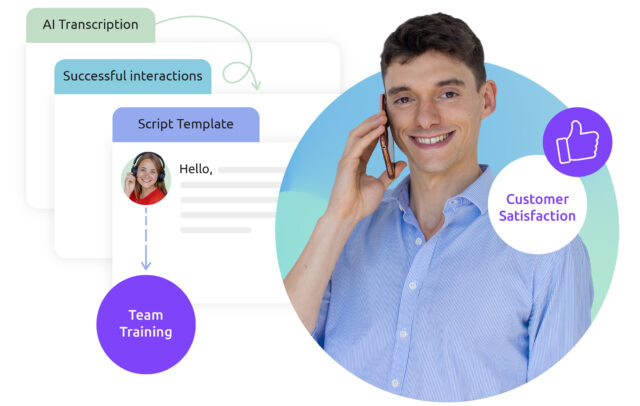
With Diabolocom's Artificial Intelligence solution
decrease in time required to gather customer context
cost savings on post-call processing
decrease in customer churn rate
Diabolocom, an AI solution built for today’s contact centers
5 out of 5 stars on Capterra
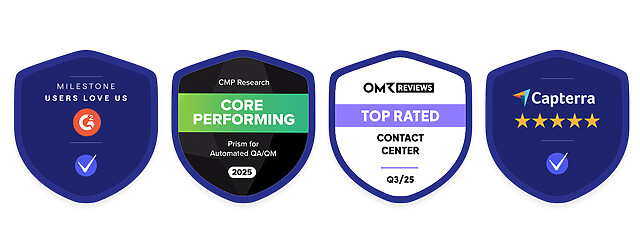
Frequently Asked Questions
What is call transcription with artificial intelligence?
Call transcription with artificial intelligence (AI) is an advanced technology that converts speech into text during telephone conversations. Using complex algorithms and machine learning, AI analyzes speech and voice to create a precise and immediate written transcript of the conversation.
This technology can recognize different accents, tones and even nuances of language, while adapting to the specific terminology of various business sectors. It can transcribe dialogues in real-time or from audio recordings, providing a basis for analyzing exchanges, training agents and improving the customer experience.
AI transcription is increasingly used in call centers to document conversations, it ensures regulatory compliance, and serves as a reference for training or quality assurance purposes. Unlike manual transcription, it is faster, more cost-effective and can be scaled to handle a large volume of calls simultaneously.
Is call transcription legal?
The legality of call transcription depends on the privacy and communications recording laws in force in each country or jurisdiction. Generally speaking, call transcription is legal provided certain conditions are met:
- Consent: It is often necessary to obtain the consent of all parties involved before recording and transcribing a telephone conversation. Consent may be explicit, where the parties are directly informed and must give their agreement, or implicit, where a recorded message advises that calls may be recorded for quality or training purposes.
- Notification: In some locations, it is necessary to inform call participants that the conversation is being recorded. This notification may be an automated message at the start of the call, or a verbal statement from the call center agent.
- Purpose: The use of transcripts must be limited to the purposes for which consent was given, such as improving service quality, training, or record keeping.
- Data protection: It is imperative to ensure the security of recorded call transcripts, protecting them from unauthorized access and complying with personal data protection laws such as the GDPR in Europe.
It is advisable to consult legal counsel to ensure compliance with local and international laws before implementing a call transcription system.
How can transcribed calls be exploited?
Transcribed calls can be exploited in many ways to improve various aspects of an organization. Here are some practical applications:
- Quality analysis: Call transcripts enable detailed analysis of customer interactions. This helps identify strengths and areas for improvement in service agents’ communication.
- Agent training: Transcribed calls can be used as training material for new employees, familiarizing them with typical call scenarios and appropriate responses.
- Compliance and Audit: For regulated industries, transcripts provide a means of verifying that calls comply with legal and procedural standards, facilitating internal or external audits.
- Product and Service Improvement: Customer feedback, faithfully captured in transcripts, is a wealth of valuable information for product development or the improvement of existing services.
- Dispute Management: In the event of disagreement or complaint, transcripts provide accurate documentation that can help resolve disputes in a factual manner.
- Process Optimization: Transcript analysis helps identify and correct recurring inefficiencies or errors in customer service processes.
- Artificial Intelligence and Machine Learning: Transcript data can be fed into AI systems to improve speech recognition and natural language understanding capabilities.
- Customer Insights and Market Trends: Recurring patterns and opinions expressed in transcripts can reveal market trends, insights into customer behavior, and opportunities for cross-selling or up-selling.
It is important to note that the use of transcripts must always respect privacy and data protection laws.
Is it possible to translate transcribed calls?
Yes, it is possible to translate transcribed calls, but this feature is not yet natively available in Diabolocom. Translation of call transcripts is currently under development and will soon be a Diabolocom proprietary technology. This innovation will enable users to easily translate their call transcriptions into different languages, directly from the Diabolocom interface, without the need for external translation tools.
Is it possible to download or export call transcriptions?
Yes, it is possible to download or export call transcripts. Currently, data can either be retrieved in JSON format via each API call, or integrated into an Excel file when previous calls are exported. This flexibility allows users to choose the format best suited to their needs. Transcripts exported in JSON format or embedded in Excel make it easy to analyze and store data for future use.
What's the difference between call transcription and voicemail transcription?
The difference between call transcription and voicemail transcription within the Diabolocom solution is as follows:
Call Transcription: This functionality applies to real-time conversations between a customer service agent and a customer. Diabolocom’s artificial intelligence transcribes these live exchanges, providing a written text of the conversation. This is useful for analyzing interactions, reducing post-call processing time and documenting customer exchanges.
Voice Message Transcription: This function focuses on voice messages left by customers outside customer service hours. AI transcribes these messages into text, enabling agents to quickly read the message content without having to listen to each recording. This transcription facilitates the management of customer queries, improves customer service responsiveness and helps organize follow-up priorities.